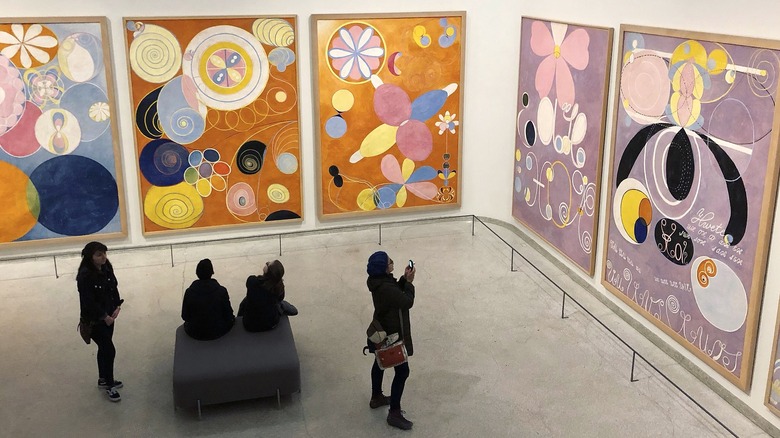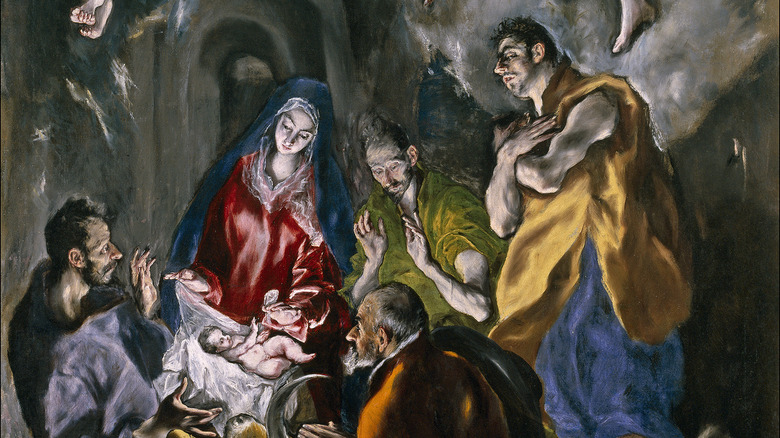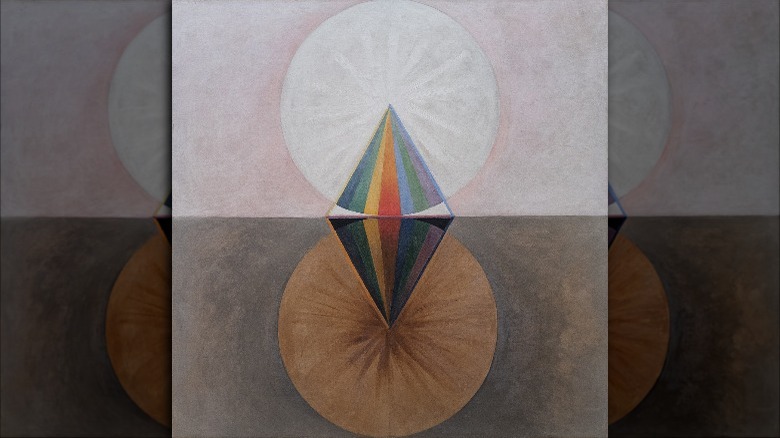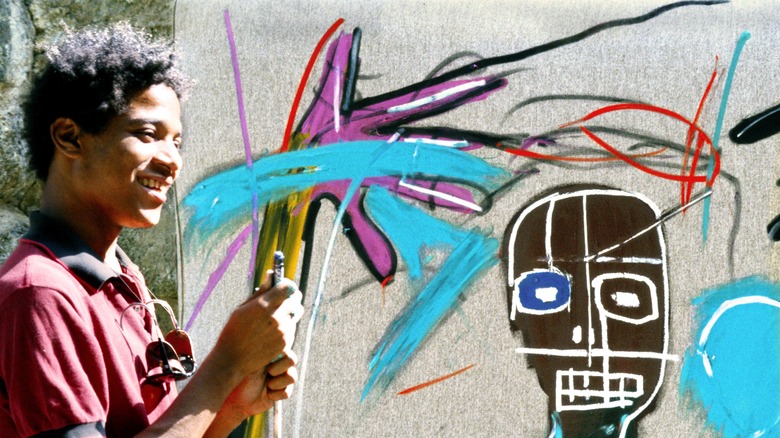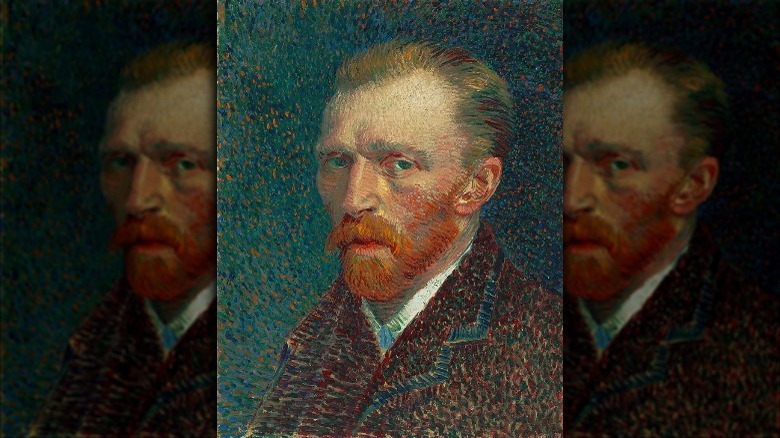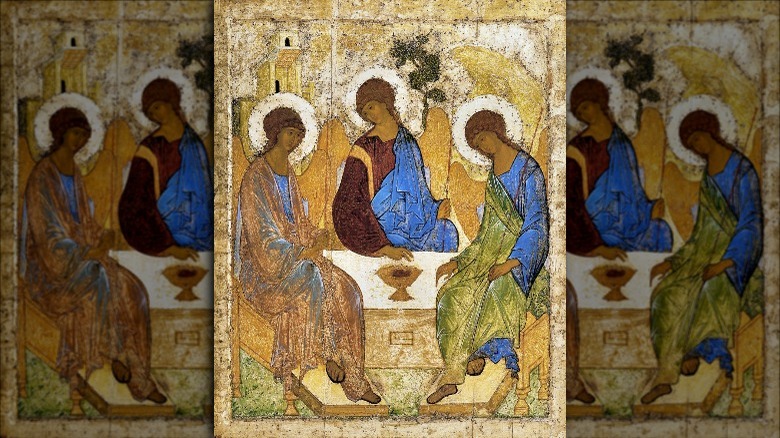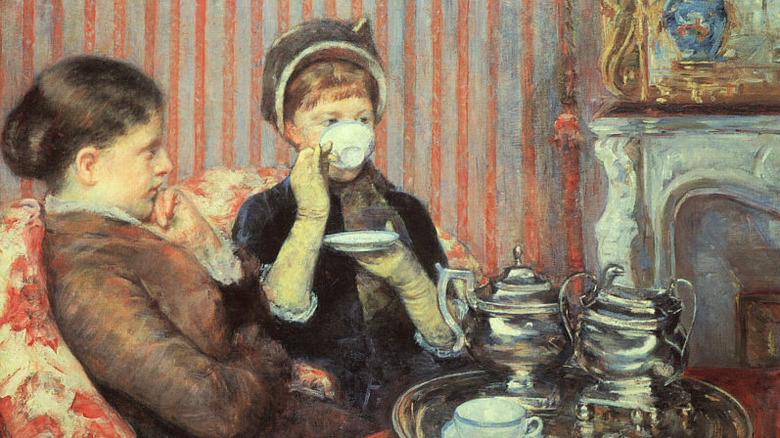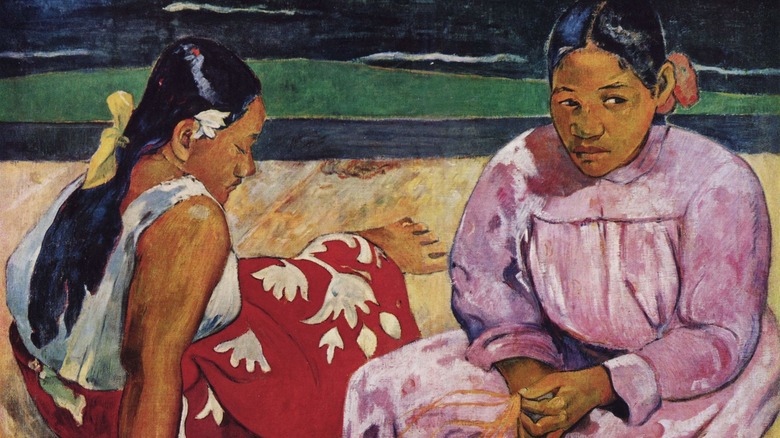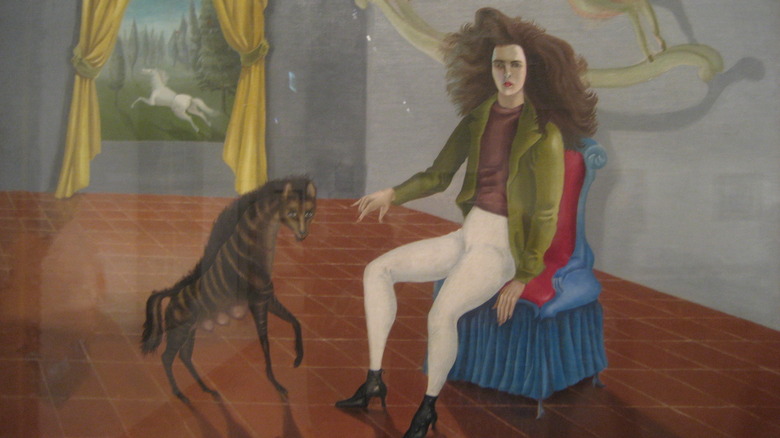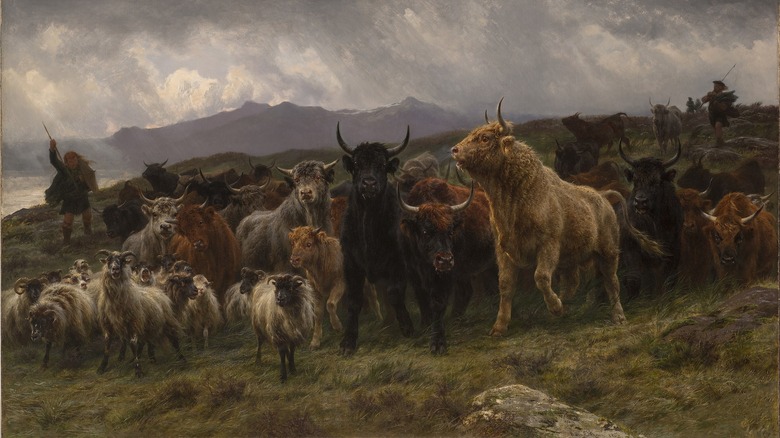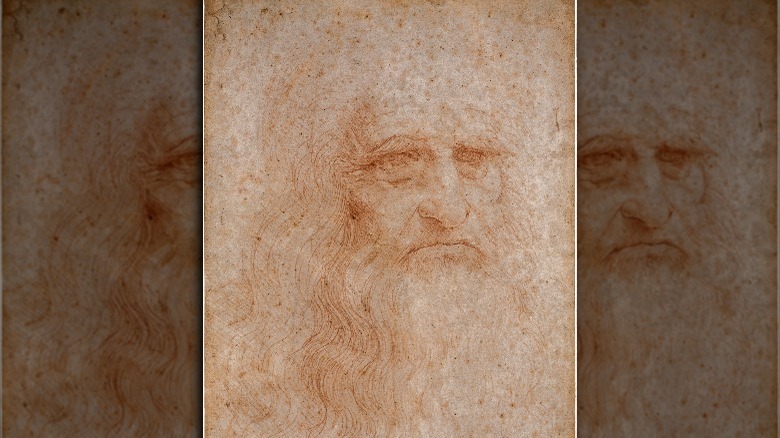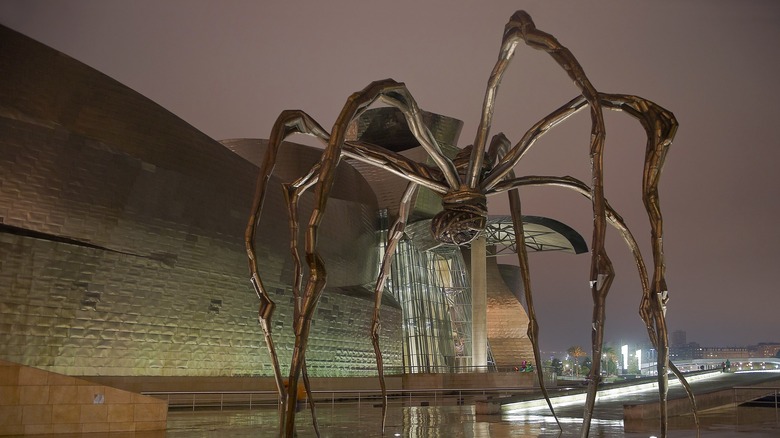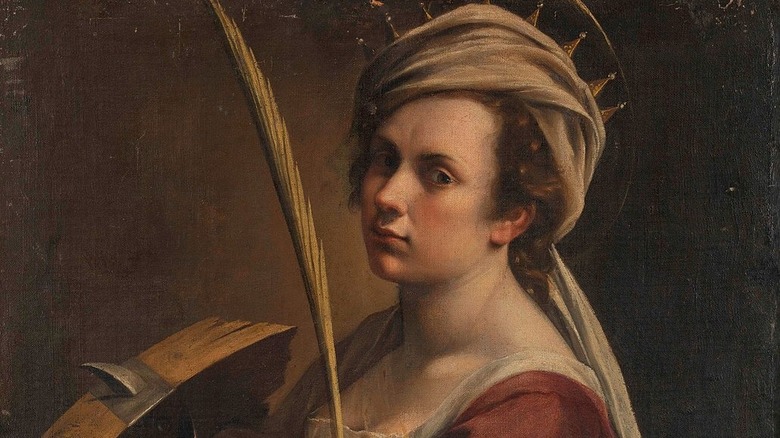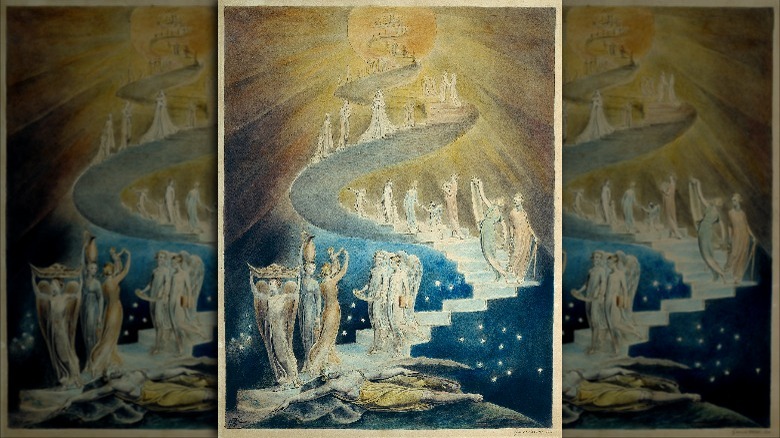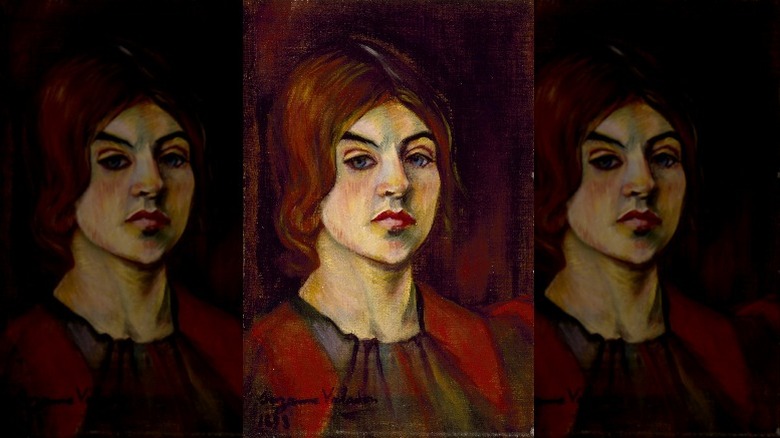Artists Who Were Ahead Of Their Time
Saying that someone is "ahead of their time" is, more often than not, an exaggeration. How, exactly, are you supposed to measure that? Is it based on a person's successes, or a lack thereof? Perhaps it's because they lived a life that, in retrospect, was pretty out of the norm and forward-thinking. Maybe they managed to make some interesting predictions or created something that would echo later achievements centuries later.
When it comes to the world of art, there are plenty of candidates for artists who were willing to go beyond mere trends. But a few stand out. Some, like the 16th century El Greco, pushed the boundaries of painting so far that simply no one painted like them. Others, like William Blake, were bold visionaries who were rejected outright in their time. And yet more, like Suzanne Valadon, bucked the entire art world to forge their own unique and vibrant paths.
El Greco defied artistic norms
Born on the island of Crete in 1541, El Greco (originally named Domenikos Theotokopoulos) may have first seemed like just another run-of-the-mill artist. As the BBC reports, young Domenikos originally trained as an icon painter, creating religious artworks that would have aligned with artistic traditions of the day.
But, by his 30s, something changed. The human figures and other forms in his work became elongated and colorful, emphasizing the spectacle of their emotion while often discarding anatomical correctness. His work became so intensely connected to expression over perfect representation that some art historians have since joked that El Greco was a time traveler (via BBC).
Though El Greco was successful enough to work as a professional artist during his life, his star faded somewhat after his death in 1614. But, as The Washington Post notes, El Greco soon came back to prominence when more modern artists began to recognize him. They included none other than Pablo Picasso, whose early works especially show clear links to the old master.
Hilma af Klint got abstract before many other artists
There was one artist, working in secret, who produced stunningly abstract works that predated even the earliest and admittedly more famous Kandinsky and Mondrian pieces by years. She was Swedish artist Hilma af Klint.
By the early 20th, af Klint was already producing abstract works on a large scale. According to The Guardian, some of her earliest abstract paintings appeared in 1906. However, because she kept her most daring work private and earned her living by selling more mundane artworks, few knew just how advanced she was until very recently. Af Klint may have been leery about sharing her more groundbreaking visuals because they were connected to her work as a spiritualist who was in connection with a being called "Amaliel" who directed her to paint on the "astral plane." Later, af Klint would also claim that she was effectively possessed by a mysterious divine force when painting these works.
In her will, she demanded that her work should remain in stasis for at least 20 years after her death in 1944. In fact, her work wasn't shown publicly until 1986 and she wasn't fully recognized on an international scale until a 2013 Swedish exhibition made the case for Hilma af Klint.
Jean-Michel Basquiat never quite fit in with the art world
First gaining fame as a graffiti artist in New York City, Jean-Michel Basquiat's work dealt with race, class, power, and more. Though he gained entry into high-flung art realms, his early adoption of political themes was groundbreaking for the time. It was surely a surprising turnaround for Basquiat as, according to Culture Trip, he was initially a high school dropout who, by the 1980s, had boldly attempted to sell postcards of his work to none other than Andy Warhol while the established artist was dining at a restaurant. Where others would have told the young upstart to buzz off, Warhol became one of Basquiat's first advocates.
The deep symbolism of Basquiat's work, which could include mysterious emblems like skulls, crowns, and birds, was used by the artist to engage with Black American history and culture. Yet, while Basquiat was soon introduced to truly high-flung realms of the art world, he was still often set aside and tokenized for his youth, race, and background, according to The New York Times. Perhaps it's this sad fact, along with the strength of Basquiat's artistic output and its powerful, complex messages, that put the young artist far ahead of his time.
Vincent van Gogh is so unique that art historians still argue over him
Even the most casual fans of art history surely know that Vincent van Gogh — he of the one "Starry Night" poster that's one every other dorm room wall — was notoriously unsuccessful during his life. It's that he sold just a few paintings while he was alive, though, as The Baltimore Sun notes, the story that van Gogh only made one sale is a bit overblown. Still, given that people have gone gaga over van Gogh in recent decades, to the point where you frankly can't escape his work, it's surprising to learn that he was largely ignored while he actually produced those paintings.
Why was he sidelined for so much of his career? It may have been because van Gogh's artwork was truly groundbreaking in its use of color and large, visible swathes of paint typically left behind by a palette knife. According to The Art Story, his work remains so unique that art historians are still arguing over whether or not he was an Impressionist or someone who was an artistic genius that transcended visual trends of his day.
Andrei Rublev was an early innovator of religious icons
For many years, icon painting had a clearly established style. The artwork produced for the Russian Orthodox Church was religious, clearly, but also formal and relatively flat. Then, Andrei Rublev began to paint. This artist, who lived and worked during the 14th and 15th centuries, brought a new sensibility to an old form.
According to The Art Story, Rublev's icons imbued the religious figures there with new life, drawing not only on the obvious skill of the painter, but also his understanding of character, depth, and motion. Rublev's art was also more gentle and hopeful, compared to the darker, more thunderous depictions of an angry deity and admittedly dour-looking figures. In short, Rublev was a true rule-breaker.
Yet, apart from the fact that he introduced a huge change to the world of icon painting, we know very little about the artist himself. Inquiries Journal notes that we can be pretty sure he was born around 1360, eventually moving near Moscow and dying in 1430. He would have lived in land wracked by political upheaval and also in a world where spirituality was central to everyday life, to the point where many speculate that Rublev was himself an Orthodox monk.
Mary Cassat was a feminist rule-breaker
Sometimes dismissed as a painter of innocuous domestic scenes, Mary Cassat was actually a groundbreaking artist who centered women's experiences and was herself an ardent suffragist. Artsy even goes so far as to argue that Cassat was able to portray the world of 19th century women in a way that was simply inaccessible for her fellow male artists. Consider how many of her paintings show women and children in a world of their own — most significantly, a world that, visually at least, is devoid of men.
Cassat's work as a female artist was also inherently groundbreaking. Born in 1844, by the time she showed an interest in an arts career, it was already odd for the daughter of a rich family to want to work for a living. So, too, was her choice of profession. At that point, artists were considered to be at the edge of morality, with daring lifestyles, scandalous life drawing classes, and relationships that upended typical family structures.
She was also deeply dedicated to women's rights in a time when many, including her fellow American women, were unable to vote. Perhaps that's why, as CBS News notes, so many of her paintings show strong, vibrant women who are living, working, and standing on their own.
Paul Gauguin was a rebel with a problematic legacy
Paul Gauguin is, by now, a widely recognized Post-Impressionist artist whose canvases sell for millions, perhaps spurred along by his unconventional and sometimes downright wild life story. As Sotheby's reports, Gauguin was initially a Parisian stockbroker who painted privately on the side. The 1882 stock market crash seems to have set the wheels in motion for Gauguin to transition from professional life into an all-encompassing artistic existence. Yet, though he had some moderate success during his lifetime, his "primitivist" style was unpopular. It wasn't until after his 1903 death that collectors soon began to swarm around his work.
Yet, while Gauguin has grown into prominence during recent decades, so too have the problematic aspects of his work. Artsy notes that some people see Gauguin — who left his French family to live in Tahiti with a series of mistresses — as a rebel who brilliantly defied social norms of his time. Others, however, see Gauguin as an extension of a long and damaging colonialist legacy, especially given how some of his most famous paintings use the bodies of native Tahitian women as focal objects without necessarily acknowledging the womens' humanity.
Leonora Carrington defied her family to become an artist
British artist Leonora Carrington's haunting Surrealist work put her in the same ranks as other 20th century Surrealists, but her art has been frequently ignored until recently. Perhaps that's because, as The New Yorker argues, Carrington's work had a distinctly feminine bent that was all too often rejected in the postwar era. Still, she was especially prodigious, producing not only visual art, but short stories and novels as well.
Her struggles with societal norms also put her ahead of her time, even compared to other avant-garde artists. Carrington had a difficult relationship with her family, aristocratic Anglo-Irish people who, according to the National Museum of Women in the Arts, would have preferred it if their daughter had been a compliant debutante instead of a wild Surrealist artist.
Cultured reports that Carrington also encountered considerable trauma and violence during World War II, including the imprisonment of her first husband in a concentration camp in 1939. Carrington traveled to Spain and experienced a mental health crisis, whereupon her family had her committed to a psychiatric institution against her will. Her treatment there, which included heavy medication regimes and electroshock therapy, was so intense that echoes of this time can still be seen in her later work. She eventually escaped — with the help of Pablo Picasso, no less — and settled in Mexico.
Rosa Bonheur lived unapologetically
The unconventional Rose Bonheur painted artwork that defied conventions for female artists of the time. Though, looking at her meticulous, luminous canvases of landscapes and domesticated animals like horses and cattle, you might not immediately realize just how much she broke the mold. It's true that Bonheur was immensely successful during her lifetime, too, though one could argue that her widespread recognition was yet another indicator that she was far ahead of her time.
According to Smithsonian Magazine, no one quite compared to Bonheur. She often tramped out into fields and slaughterhouses to study the anatomy of the animals who so often populated her paintings. That, combined with her particular talent for marketing herself to the rich and famous of Europe, showed that she was no shy and retiring artist who was content only to paint placid domestic scenes.
Bonheur's image and personal life were also noteworthy, even for 19th century artists. She lived, as much as she could be for the time, as masculine a lifestyle as she could. Bonheur wore pants, smoked her hand-rolled cigarettes, and wasn't above a dirty joke or two when in the right company. She also lived, as much as she could have at the time, as an open lesbian, according to The Legacy Project. She once even said that "As far a males go, I only like the bulls I paint" (via The National Gallery).
Leonardo da Vinci was undeniably ahead of his time
It's a cliché now, but there's really no denying that Renaissance artist Leonardo da Vinci truly was ahead of his time. Just a casual glance at his body of work, which includes not only classic-style paintings, but engineering diagrams, anatomical treatises, architectural plans, and even one surviving sculpture (via NPR) proves that he is the epitome of the "Renaissance man".
Though the European Renaissance was seemingly packed full of brilliant artists, from Raphael to Michelangelo, da Vinci's voracious mind made him stand out above the rest. Sheffield Hallam University notes that he not only had a masterful understanding of engineering but, critically, had the imagination and drive to take the concepts he'd learned and apply them in new and innovative ways.
It's true that, under modern scrutiny, his designs for tanks and an "aerial screw" would need quite a lot of modification before they could work properly. But it's the audacity of his thought processes, combined with his artistic and mathematical skills, that set da Vinci far ahead of his own time.
Louise Bourgeois pushed artistic boundaries for decades
Even in the famously avant-garde, sometimes outrageous world of modern art, Louise Bourgeois stood out. Her work took on deeply personal themes of mortality, sexuality, and other big issues that remained on the cutting edge of contemporary art, even though she maintained her status as a working artist for nearly 80 years.
Bourgeois' engagement with the more troubling aspects of her life was, in many ways, a precursor to the deeply intimate confessional works that are increasingly popular today. The Tate reports that young Louise's mother was often ill and died when Louise was 22, despite her daughter's frequent care. It didn't help that, for a significant portion of her childhood, World War I was also raging in the background of her first home of France (via The Easton Foundation).
Starting in the 1930s, Bourgeois began producing work that, throughout her career, continued to push the boundaries even for emerging artists. In an interview with Vulture, her longtime assistant, Jerry Gorovoy, said, "Her new work was as contemporary as anything being made at the time."
Artemisia Gentileschi forged a bold life as a female artist
The Italian Artemisia Gentileschi was a female artist in the 17th century, when women were rare creators indeed within the art world. She had a bit of a leg up though, since her own father, Orazio, was a working artist, as Varsity reports. But, when Orazio hired a private tutor for his promising young daughter, the tutor sexually assaulted her. Artemisia was eventually subjected to a traumatic trial that resulted in few, if any, real consequences for her attacker. Now, many art historians argue that this early, scarring experience pushed her to depict a series of powerful women — some of whom are attacking villainous, lecherous men.
Gentileschi's feminist themes and semi-confessional style were truly unique for her time, when many other artists painted flattering portraits of their patrons or popular artworks for religious settings. Gentileschi's work certainly ties into those themes, but, as The Atlantic notes, her painted figures are moving and dynamic in a way that few other artists of her time truly managed to achieve. So, too, are the emotions that seem so easy to read for some modern viewers, like the rage evident in her depiction of the violent beheading of Holofernes by Biblical heroine Judith.
William Blake knew that he didn't fit in with his time
Largely ignored during his time, William Blake is now widely recognized for his deeply imaginative, almost hallucinatory work that set him far apart from other artists of the 18th and 19th century.
Few would have guessed that young Blake was going to be an artist, as The New York Times notes that he was the son of a businessman. William's father eventually decided that his sensitive son wasn't fit for school and instead began enrolling him in art classes. Blake also began writing poetry at an early age.
Blake just wasn't terribly successful in his lifetime, the BBC reports. He sold few works, had only one solo show, and was generally ignored. But Blake himself was convinced that he would be better understood by later generations, maintaining that he "laboured upwards to futurity." And it's true that his intense, introspective, and sometimes even prophetic artworks are more studied today.
Suzanne Valadon ignored the typical path to the art world
Suzanne Valadon was often ignored by other artists and art historians after her death. Perhaps it's because she was a woman, or else because she wasn't formally trained as an artist. In fact, as Nuvo reports, Valadon was initially more well known in the 19th century art world as a model, a profession that was both vital to the production of art and also considered to be rather scandalous. Before that, Valadon was actually a circus performer but, upon injuring herself, began to create her own art during her recovery period.
Because she didn't have the money typically required to gain entry into the Parisian art world as a proper artist, she began modelling. Valadon used the opportunity to get closer to artists such as Henri Degas, who would eventually help Valadon shape her own art career.
Valadon's bold vision and feminist ideals show that she was truly ahead of her time. Per CNN, she became known for her paintings of nude figures, depicting both men and women of many ages and shapes. Her female figures especially were energetic and bold, with none of the wispy delicacy that was so often expected of early 20th century women. Though she was moderately successful during her life, Valadon's name slipped into obscurity for years after her 1938 death, only to be recently brought back into the light.
